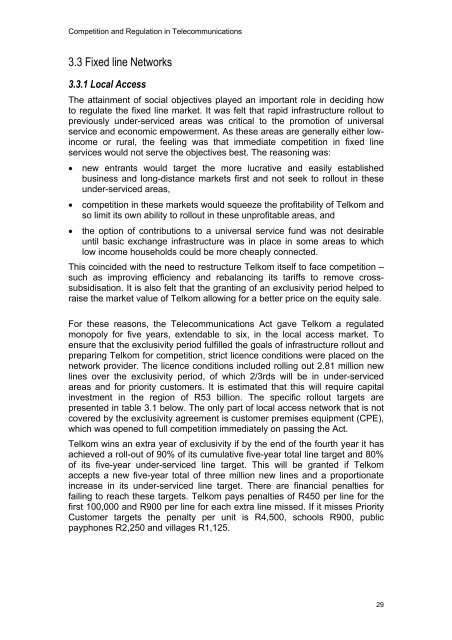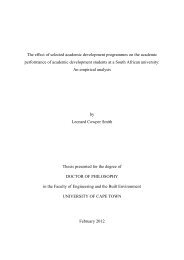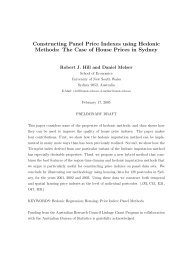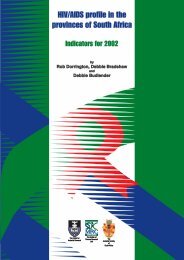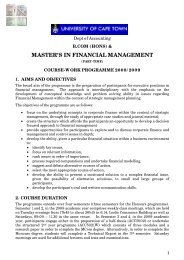Competition and Regulation in the Telecommunications Industry in ...
Competition and Regulation in the Telecommunications Industry in ...
Competition and Regulation in the Telecommunications Industry in ...
Create successful ePaper yourself
Turn your PDF publications into a flip-book with our unique Google optimized e-Paper software.
<strong>Competition</strong> <strong>and</strong> <strong>Regulation</strong> <strong>in</strong> <strong>Telecommunications</strong>3.3 Fixed l<strong>in</strong>e Networks3.3.1 Local AccessThe atta<strong>in</strong>ment of social objectives played an important role <strong>in</strong> decid<strong>in</strong>g howto regulate <strong>the</strong> fixed l<strong>in</strong>e market. It was felt that rapid <strong>in</strong>frastructure rollout topreviously under-serviced areas was critical to <strong>the</strong> promotion of universalservice <strong>and</strong> economic empowerment. As <strong>the</strong>se areas are generally ei<strong>the</strong>r low<strong>in</strong>comeor rural, <strong>the</strong> feel<strong>in</strong>g was that immediate competition <strong>in</strong> fixed l<strong>in</strong>eservices would not serve <strong>the</strong> objectives best. The reason<strong>in</strong>g was:• new entrants would target <strong>the</strong> more lucrative <strong>and</strong> easily establishedbus<strong>in</strong>ess <strong>and</strong> long-distance markets first <strong>and</strong> not seek to rollout <strong>in</strong> <strong>the</strong>seunder-serviced areas,• competition <strong>in</strong> <strong>the</strong>se markets would squeeze <strong>the</strong> profitability of Telkom <strong>and</strong>so limit its own ability to rollout <strong>in</strong> <strong>the</strong>se unprofitable areas, <strong>and</strong>• <strong>the</strong> option of contributions to a universal service fund was not desirableuntil basic exchange <strong>in</strong>frastructure was <strong>in</strong> place <strong>in</strong> some areas to whichlow <strong>in</strong>come households could be more cheaply connected.This co<strong>in</strong>cided with <strong>the</strong> need to restructure Telkom itself to face competition –such as improv<strong>in</strong>g efficiency <strong>and</strong> rebalanc<strong>in</strong>g its tariffs to remove crosssubsidisation.It is also felt that <strong>the</strong> grant<strong>in</strong>g of an exclusivity period helped toraise <strong>the</strong> market value of Telkom allow<strong>in</strong>g for a better price on <strong>the</strong> equity sale.For <strong>the</strong>se reasons, <strong>the</strong> <strong>Telecommunications</strong> Act gave Telkom a regulatedmonopoly for five years, extendable to six, <strong>in</strong> <strong>the</strong> local access market. Toensure that <strong>the</strong> exclusivity period fulfilled <strong>the</strong> goals of <strong>in</strong>frastructure rollout <strong>and</strong>prepar<strong>in</strong>g Telkom for competition, strict licence conditions were placed on <strong>the</strong>network provider. The licence conditions <strong>in</strong>cluded roll<strong>in</strong>g out 2.81 million newl<strong>in</strong>es over <strong>the</strong> exclusivity period, of which 2/3rds will be <strong>in</strong> under-servicedareas <strong>and</strong> for priority customers. It is estimated that this will require capital<strong>in</strong>vestment <strong>in</strong> <strong>the</strong> region of R53 billion. The specific rollout targets arepresented <strong>in</strong> table 3.1 below. The only part of local access network that is notcovered by <strong>the</strong> exclusivity agreement is customer premises equipment (CPE),which was opened to full competition immediately on pass<strong>in</strong>g <strong>the</strong> Act.Telkom w<strong>in</strong>s an extra year of exclusivity if by <strong>the</strong> end of <strong>the</strong> fourth year it hasachieved a roll-out of 90% of its cumulative five-year total l<strong>in</strong>e target <strong>and</strong> 80%of its five-year under-serviced l<strong>in</strong>e target. This will be granted if Telkomaccepts a new five-year total of three million new l<strong>in</strong>es <strong>and</strong> a proportionate<strong>in</strong>crease <strong>in</strong> its under-serviced l<strong>in</strong>e target. There are f<strong>in</strong>ancial penalties forfail<strong>in</strong>g to reach <strong>the</strong>se targets. Telkom pays penalties of R450 per l<strong>in</strong>e for <strong>the</strong>first 100,000 <strong>and</strong> R900 per l<strong>in</strong>e for each extra l<strong>in</strong>e missed. If it misses PriorityCustomer targets <strong>the</strong> penalty per unit is R4,500, schools R900, publicpayphones R2,250 <strong>and</strong> villages R1,125.29


